Metallurgical and Mechanical Characteristics of an AA5183 Alloy Plate Performed by a Cold Metal Low-Power Additive Manufacturing Technology
Abstract
:1. Introduction
2. Experimental Procedures
2.1. Investigated Material
2.2. Layer Deposition
2.3. Microscopic Observation
2.4. Mechanical Performance Tests
3. Results
3.1. Microscopic Inspection
3.2. Microstructure of Deposited 5183 Al Alloy Plate
3.3. Mechanical Properties of Deposited 5183 Al Alloy Plate
4. Discussion
4.1. Characteristics of Defects and Microstructures
4.1.1. Analysis of Pore Formation
4.1.2. Analysis of Alloy Element Distributions
4.1.3. Analysis of Grain Characteristics
4.2. Mechanisms Responsible for Enhanced Strength
4.2.1. Solid Solution Strengthening
4.2.2. Grain Boundary Strengthening
4.2.3. Secondary Phase Strengthening
5. Conclusions
- Pore size and porosity are linearly distributed parallel to the deposited layer and exist between deposited layers. From the lower part to the upper part of the deposited Al alloy plate, the porosity gradually increases. Due to the different porosity and pore size at different locations, the elongation in the vertical direction is affected, and the elongation of the upper region is lower than that of the lower region. The elongation in the horizontal direction is higher than that in the vertical direction;
- The mechanical properties of the samples oriented in two different directions in four regions were investigated. Due to the high porosity between the deposited layers in the vertical samples, the fracture surface of the vertical samples is located between the deposited layers. Perpendicular to the building direction, the vertical samples present excellent strength and ductility. The mean average ultimate tensile strengths of the upper and lower samples were 322 ± 2.4 MPa and 327.7 ± 0.6 MPa, respectively, with 31.5 ± 2.4% and 30.6 ± 2.0% ductility, respectively;
- The upper region of the cross section of the deposited plate is mainly composed of equiaxed grains, and the middle and lower regions are mainly composed of periodically arranged equiaxed grains and columnar grains. Further, the grain size gradually increases along the building direction;
- The crystal structure of the particles of the second phase Al6(Mn, Fe) was characterized. The size of the secondary phase crystals gradually increases, and the distribution coefficient gradually decreases along the deposition direction. Al3Mg2 fine grains exist between the Al6(Mn, Fe) secondary phase particles and the Al matrix;
- There are three main strengthening mechanisms affecting the strength of a deposited plate. Through calculation and analysis, the contributions of solution strengthening, grain boundary strengthening, and secondary phase strengthening are found to be 67.1 MPa, 38.2 MPa, and 125.1 MPa, respectively.
Author Contributions
Funding
Data Availability Statement
Acknowledgments
Conflicts of Interest
References
- Ngo, T.D.; Kashani, A.; Imbalzano, G.; Nguyen, K.T.Q.; Hui, D. Additive manufacturing (3D printing): A review of materials, methods, applications and challenges. Compos. Part B Eng. 2018, 143, 172–196. [Google Scholar] [CrossRef]
- Attaran, M. The rise of 3-D printing: The advantages of additive manufacturing over traditional manufacturing. Bus. Horiz. 2017, 60, 677–688. [Google Scholar] [CrossRef]
- Durai Murugan, P.; Vijayananth, S.; Natarajan, M.P.; Jayabalakrishnan, D.; Arul, K.; Jayaseelan, V.; Elanchezhian, J. A current state of metal additive manufacturing methods: A review. Mater. Today Proc. 2022, 59, 1277–1283. [Google Scholar] [CrossRef]
- Gong, G.; Ye, J.; Chi, Y.; Zhao, Z.; Wang, Z.; Xia, G.; Du, X.; Tian, H.; Yu, H.; Chen, C. Research status of laser additive manufacturing for metal: A review. J. Mater. Res. Technol. 2021, 15, 855–884. [Google Scholar] [CrossRef]
- Kalashnikov, K.N.; Chumaevskii, A.V.; Kalashnikova, T.A.; Kolubaev, E.A. A substrate material and thickness influence on the 3D-printing of Ti–6Al–4V components via wire-feed electron beam additive manufacturing. J. Mater. Res. Technol. 2022, 16, 840–852. [Google Scholar] [CrossRef]
- Huan, P.-C.; Wang, X.-N.; Zhang, Q.-Y.; Di, H.-S.; Chen, X.-M.; Chen, Y.; Wei, X. Study on droplet transition behavior, bead geometric characteristics and formability of wire + arc additively manufactured Inconel 718 alloy by using CMT MIX+ Synchropulse process. J. Mater. Res. Technol. 2022, 17, 1831–1841. [Google Scholar] [CrossRef]
- Kawalkar, R.; Kumar Dubey, H.; Lokhande, S.P. Wire arc additive manufacturing: A brief review on advancements in addressing industrial challenges incurred with processing metallic alloys. Mater. Today Proc. 2022, 50, 1971–1978. [Google Scholar] [CrossRef]
- Chaturvedi, M.; Scutelnicu, E.; Rusu, C.C.; Mistodie, L.R.; Mihailescu, D.; Subbiah, A.V. Wire Arc Additive Manufacturing: Review on Recent Findings and Challenges in Industrial Applications and Materials Characterization. Metals 2021, 11, 939. [Google Scholar] [CrossRef]
- Rodrigues, T.A.; Duarte, V.R.; Miranda, R.M.; Santos, T.G.; Oliveira, J.P. Ultracold-Wire and arc additive manufacturing (UC-WAAM). J. Mater. Process. Technol. 2021, 296, 117196. [Google Scholar] [CrossRef]
- Ke, W.C.; Oliveira, J.P.; Cong, B.Q.; Ao, S.S.; Qi, Z.W.; Peng, B.; Zeng, Z. Multi-layer deposition mechanism in ultra high-frequency pulsed wire arc additive manufacturing (WAAM) of NiTi shape memory alloys. Addit. Manuf. 2022, 50, 102513. [Google Scholar] [CrossRef]
- Ayarkwa, K.F.; Williams, S.W.; Ding, J. Assessing the effect of TIG alternating current time cycle on aluminium wire + arc additive manufacture. Addit. Manuf. 2017, 18, 186–193. [Google Scholar] [CrossRef]
- Su, C.; Chen, X.; Gao, C.; Wang, Y. Effect of heat input on microstructure and mechanical properties of Al-Mg alloys fabricated by WAAM. Appl. Surf. Sci. 2019, 486, 431–440. [Google Scholar] [CrossRef]
- Wang, Y.; Xu, X.; Zhao, Z.; Deng, W.; Han, J.; Bai, L.; Liang, X.; Yao, J. Coordinated monitoring and control method of deposited layer width and reinforcement in WAAM process. J. Manuf. Process. 2021, 71, 306–316. [Google Scholar] [CrossRef]
- Campatelli, G.; Campanella, D.; Barcellona, A.; Fratini, L.; Grossi, N.; Ingarao, G. Microstructural, mechanical and energy demand characterization of alternative WAAM techniques for Al-alloy parts production. CIRP J. Manuf. Sci. Technol. 2020, 31, 492–499. [Google Scholar] [CrossRef]
- Wu, D.; Liu, D.; Niu, F.; Miao, Q.; Zhao, K.; Tang, B.; Bi, G.; Ma, G. Al–Cu alloy fabricated by novel laser-tungsten inert gas hybrid additive manufacturing. Addit. Manuf. 2020, 32, 100954. [Google Scholar] [CrossRef]
- Gu, J.; Zhang, Y.; Xu, Y.; Liu, S.; Bai, J.; Fang, X. In-situ precipitation of metastable phases and microstructure control for additively manufactured Al alloy. Mater. Lett. 2022, 309, 131447. [Google Scholar] [CrossRef]
- Wang, J.F.; Sun, Q.J.; Wang, H.; Liu, J.P.; Feng, J.C. Effect of location on microstructure and mechanical properties of additive layer manufactured Inconel 625 using gas tungsten arc welding. Mater. Sci. Eng. A 2016, 676, 395–405. [Google Scholar] [CrossRef]
- Wu, B.; Pan, Z.; Ding, D.; Cuiuri, D.; Li, H.; Xu, J.; Norrish, J. A review of the wire arc additive manufacturing of metals: Properties, defects and quality improvement. J. Manuf. Process. 2018, 35, 127–139. [Google Scholar] [CrossRef]
- Fang, X.; Zhang, L.; Chen, G.; Dang, X.; Huang, K.; Wang, L.; Lu, B. Correlations between Microstructure Characteristics and Mechanical Properties in 5183 Aluminium Alloy Fabricated by Wire-Arc Additive Manufacturing with Different Arc Modes. Materials 2018, 11, 2075. [Google Scholar] [CrossRef]
- Derekar, K.S.; Addison, A.; Joshi, S.S.; Zhang, X.; Lawrence, J.; Xu, L.; Melton, G.; Griffiths, D. Effect of pulsed metal inert gas (pulsed-MIG) and cold metal transfer (CMT) techniques on hydrogen dissolution in wire arc additive manufacturing (WAAM) of aluminium. Int. J. Adv. Manuf. Technol. 2020, 107, 311–331. [Google Scholar] [CrossRef]
- Posch, G.; Ferdinand, K.; Heinz, H.; Harald, C. Manufacturing of Turbine Blades by Shape Giving Cmt-Welding. In Proceedings of the Metal Additive Manufacturing Conference, Vienna, Austria, 20–21 November 2014. [Google Scholar]
- Gu, J.; Ding, J.; Williams, S.W.; Gu, H.; Ma, P.; Zhai, Y. The effect of inter-layer cold working and post-deposition heat treatment on porosity in additively manufactured aluminum alloys. J. Mater. Process. Technol. 2016, 230, 26–34. [Google Scholar] [CrossRef]
- Liu, L.; Ao, W.; Wen, Z.; Wang, Y.; Long, Y.; Liu, P.; He, G.; Li, L.K.B. Modifying the ignition, combustion and agglomeration characteristics of composite propellants via Al-Mg alloy additives. Combust. Flame 2022, 238, 111926. [Google Scholar] [CrossRef]
- Li, F.; Chen, S.; Shi, J.; Zhao, Y.; Tian, H. Thermoelectric Cooling-Aided Bead Geometry Regulation in Wire and Arc-Based Additive Manufacturing of Thin-Walled Structures. Appl. Sci. 2018, 8, 207. [Google Scholar] [CrossRef]
- Dong, B.; Cai, X.; Lin, S.; Fan, C. Microstructures and mechanical properties of wire arc additive manufactured 5183-Al: Influences of deposition dimensions. CIRP J. Manuf. Sci. Technol. 2021, 35, 744–752. [Google Scholar] [CrossRef]
- Jahangiri, A.; Marashi, S.P.H.; Mohammadaliha, M.; Ashofte, V. The effect of pressure and pouring temperature on the porosity, microstructure, hardness and yield stress of AA2024 aluminum alloy during the squeeze casting process. J. Mater. Process. Technol. 2017, 245, 1–6. [Google Scholar] [CrossRef]
- Guo, Y.; Quan, G.; Celikin, M.; Ren, L.; Zhan, Y.; Fan, L.; Pan, H. Effect of heat treatment on the microstructure and mechanical properties of AZ80M magnesium alloy fabricated by wire arc additive manufacturing. J. Magnes. Alloy. 2022, 10, 1930–1940. [Google Scholar] [CrossRef]
- Mazur, M. Porosity in aluminium welds. Weld. Int. 1992, 6, 929–931. [Google Scholar] [CrossRef]
- Panchenko, O.; Kurushkin, D.; Mushnikov, I.; Khismatullin, A.; Popovich, A. A high-performance WAAM process for Al–Mg–Mn using controlled short-circuiting metal transfer at increased wire feed rate and increased travel speed. Mater. Des. 2020, 195, 109040. [Google Scholar] [CrossRef]
- Gu, J.; Gao, M.; Yang, S.; Bai, J.; Zhai, Y.; Ding, J. Microstructure, defects, and mechanical properties of wire + arc additively manufactured Al Cu4.3-Mg1.5 alloy. Mater. Des. 2020, 186, 108357. [Google Scholar] [CrossRef]
- Gu, J.; Gao, M.; Yang, S.; Bai, J.; Ding, J.; Fang, X. Pore formation and evolution in wire + arc additively manufactured 2319 Al alloy. Addit. Manuf. 2019, 30, 100900. [Google Scholar] [CrossRef]
- Aldalur, E.; Suárez, A.; Veiga, F. Metal transfer modes for Wire Arc Additive Manufacturing Al-Mg alloys: Influence of heat input in microstructure and porosity. J. Mater. Process. Technol. 2021, 297, 117271. [Google Scholar] [CrossRef]
- Ternero, F.; Rosa, L.G.; Urban, P.; Montes, J.M.; Cuevas, F.G. Influence of the Total Porosity on the Properties of Sintered Materials—A Review. Metals 2021, 11, 730. [Google Scholar] [CrossRef]
- He, P.; Webster, R.F.; Yakubov, V.; Kong, H.; Yang, Q.; Huang, S.; Ferry, M.; Kruzic, J.J.; Li, X. Fatigue and dynamic aging behavior of a high strength Al-5024 alloy fabricated by laser powder bed fusion additive manufacturing. Acta Mater. 2021, 220, 117312. [Google Scholar] [CrossRef]
- Koju, R.K.; Mishin, Y. Atomistic study of grain-boundary segregation and grain-boundary diffusion in Al-Mg alloys. Acta Mater. 2020, 201, 596–603. [Google Scholar] [CrossRef]
- Ceschini, L.; Boromei, I.; Morri, A.; Seifeddine, S.; Svensson, I.L. Microstructure, tensile and fatigue properties of the Al–10%Si–2%Cu alloy with different Fe and Mn content cast under controlled conditions. J. Mater. Process. Technol. 2009, 209, 5669–5679. [Google Scholar] [CrossRef]
- Jia, Q.; Zhang, F.; Rometsch, P.; Li, J.; Mata, J.; Weyland, M.; Bourgeois, L.; Sui, M.; Wu, X. Precipitation kinetics, microstructure evolution and mechanical behavior of a developed Al–Mn–Sc alloy fabricated by selective laser melting. Acta Mater. 2020, 193, 239–251. [Google Scholar] [CrossRef]
- Wei, H.L.; Elmer, J.W.; DebRoy, T. Origin of grain orientation during solidification of an aluminum alloy. Acta Mater. 2016, 115, 123–131. [Google Scholar] [CrossRef]
- Liu, D.; Wu, D.; Wang, R.; Shi, J.; Niu, F.; Ma, G. Formation mechanism of Al-Zn-Mg-Cu alloy fabricated by laser-arc hybrid additive manufacturing: Microstructure evaluation and mechanical properties. Addit. Manuf. 2022, 50, 102554. [Google Scholar] [CrossRef]
- Li, G.; Brodu, E.; Soete, J.; Wei, H.; Liu, T.; Yang, T.; Liao, W.; Vanmeensel, K. Exploiting the rapid solidification potential of laser powder bed fusion in high strength and crack-free Al-Cu-Mg-Mn-Zr alloys. Addit. Manuf. 2021, 47, 102210. [Google Scholar] [CrossRef]
- Ma, K.; Wen, H.; Hu, T.; Topping, T.D.; Isheim, D.; Seidman, D.N.; Lavernia, E.J.; Schoenung, J.M. Mechanical behavior and strengthening mechanisms in ultrafine grain precipitation-strengthened aluminum alloy. Acta Mater. 2014, 62, 141–155. [Google Scholar] [CrossRef]
- Zhou, L.; Hyer, H.; Park, S.; Pan, H.; Bai, Y.; Rice, K.P.; Sohn, Y. Microstructure and mechanical properties of Zr-modified aluminum alloy 5083 manufactured by laser powder bed fusion. Addit. Manuf. 2019, 28, 485–496. [Google Scholar] [CrossRef]

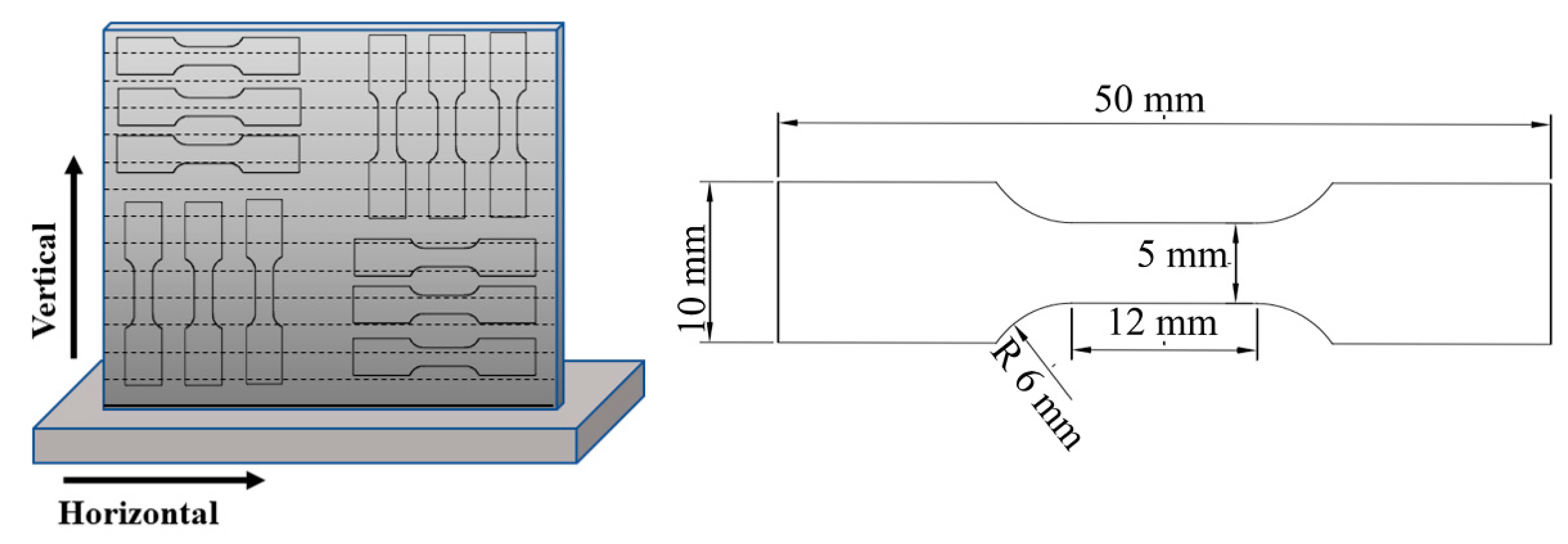
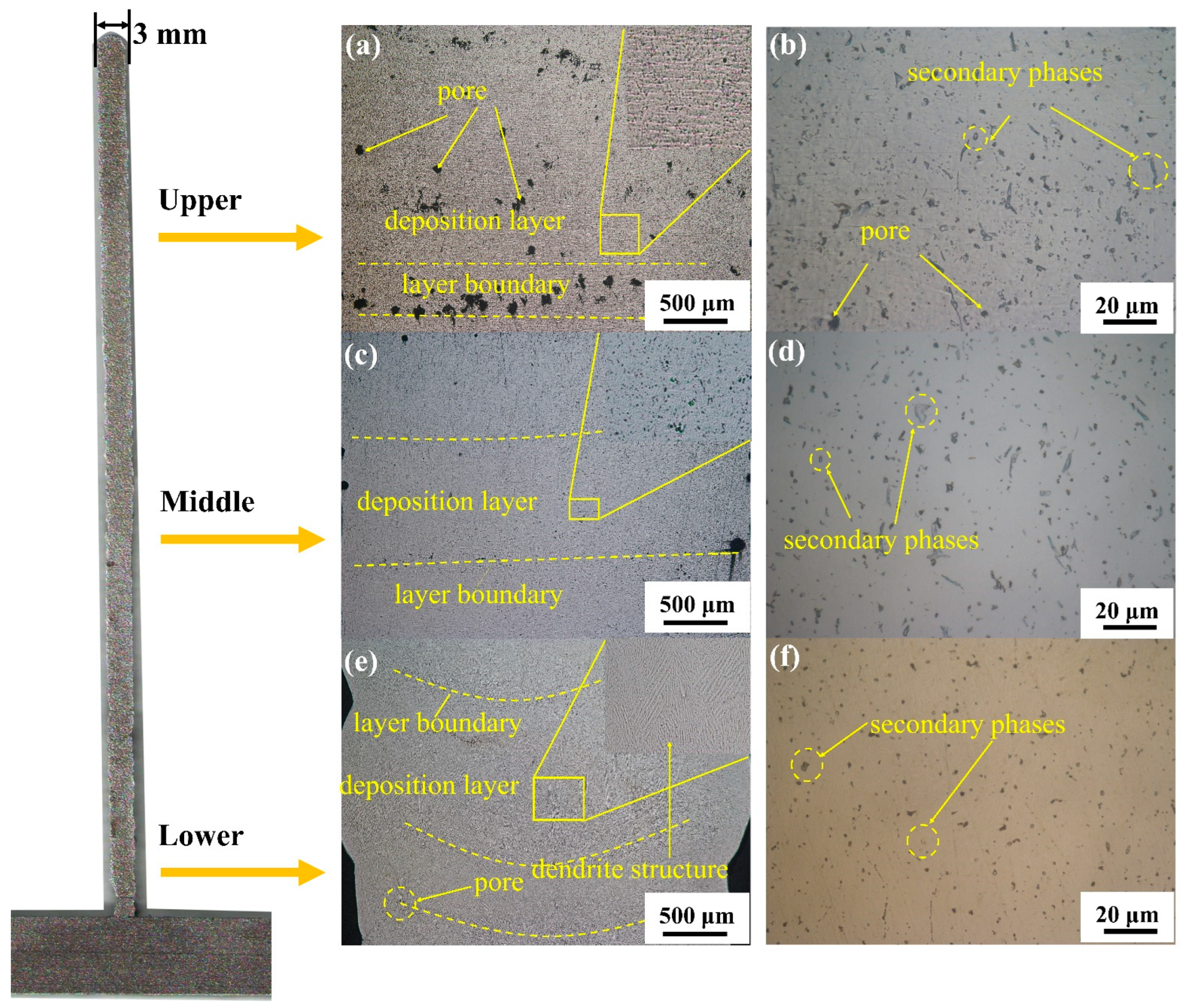

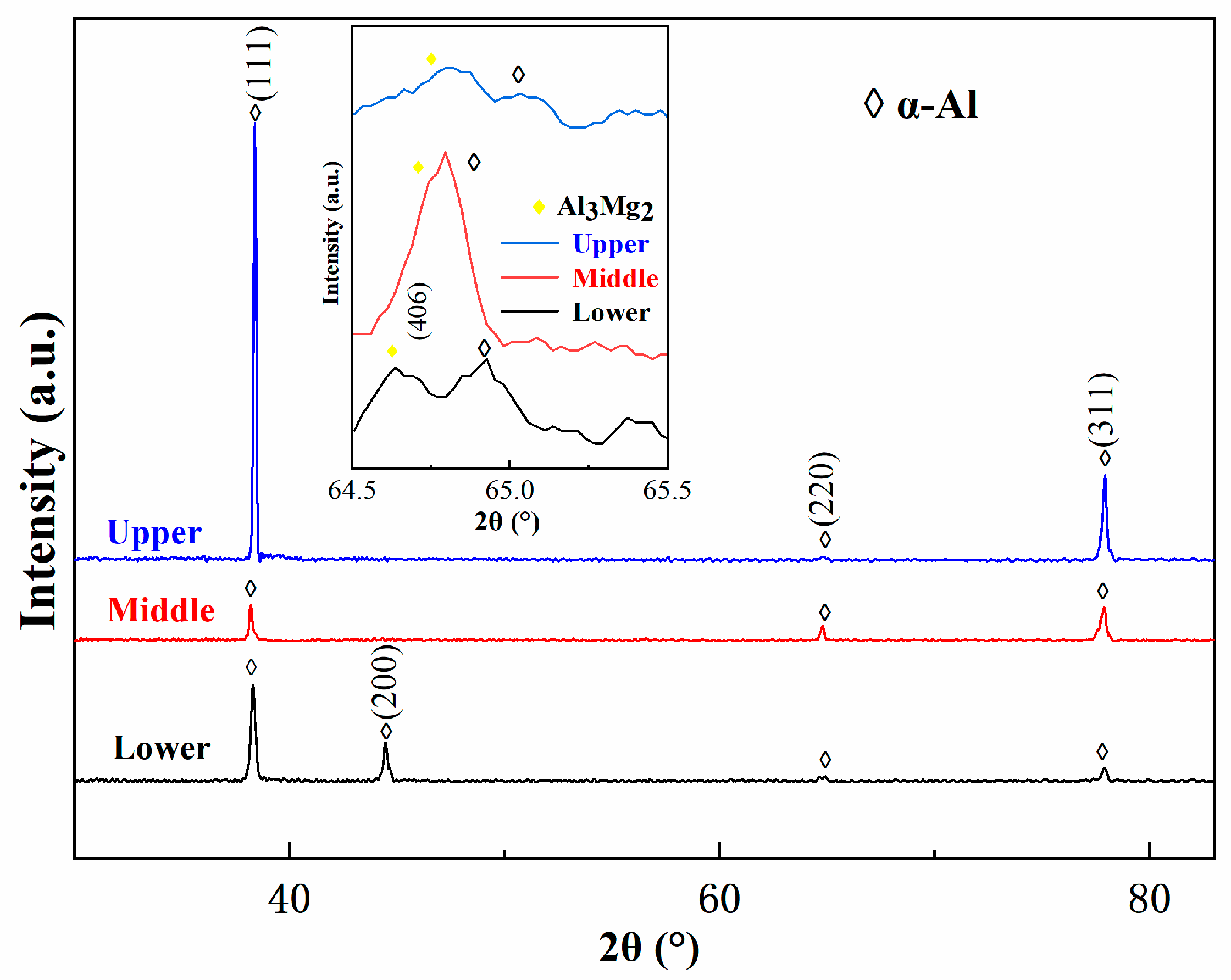
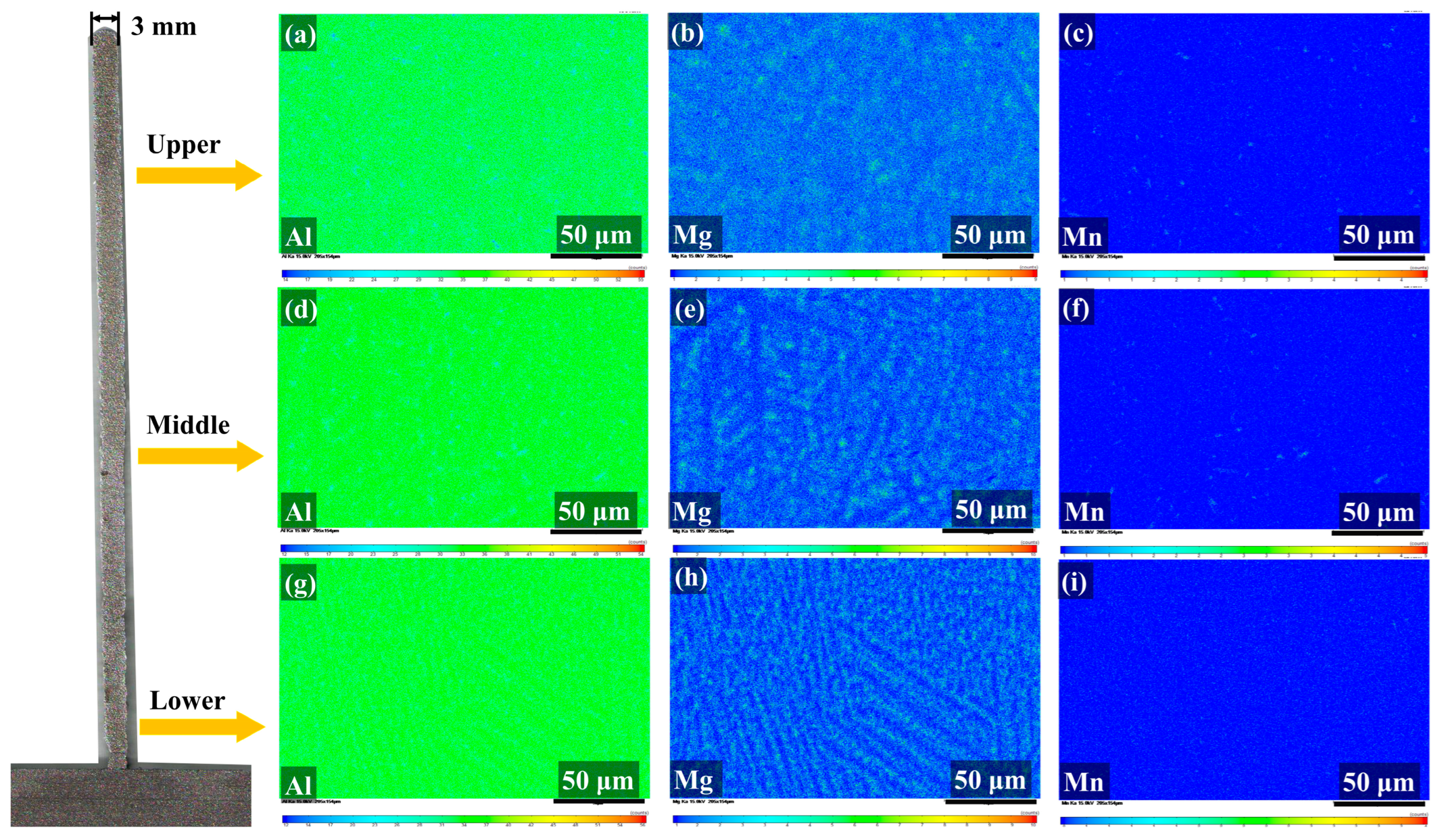

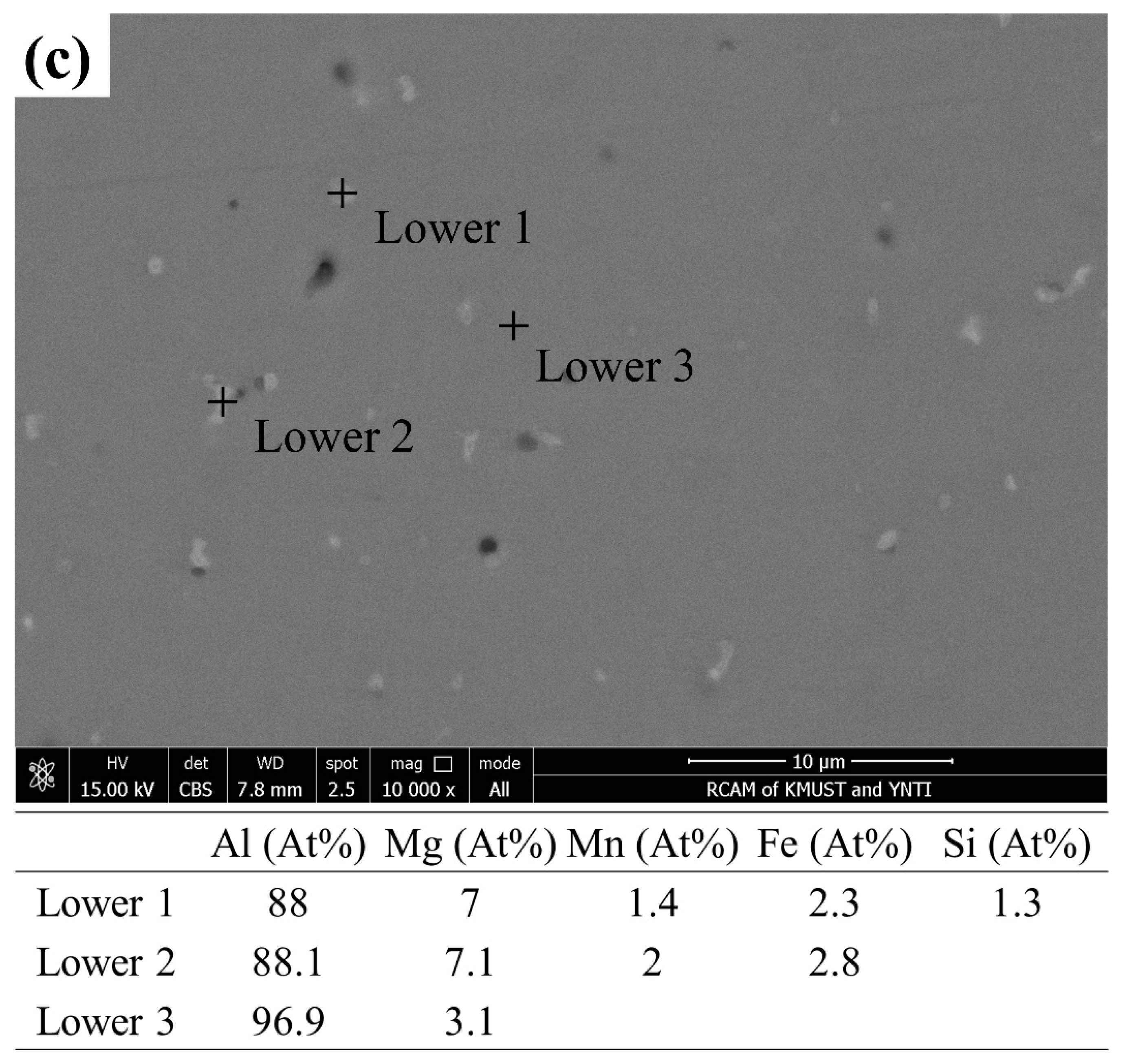
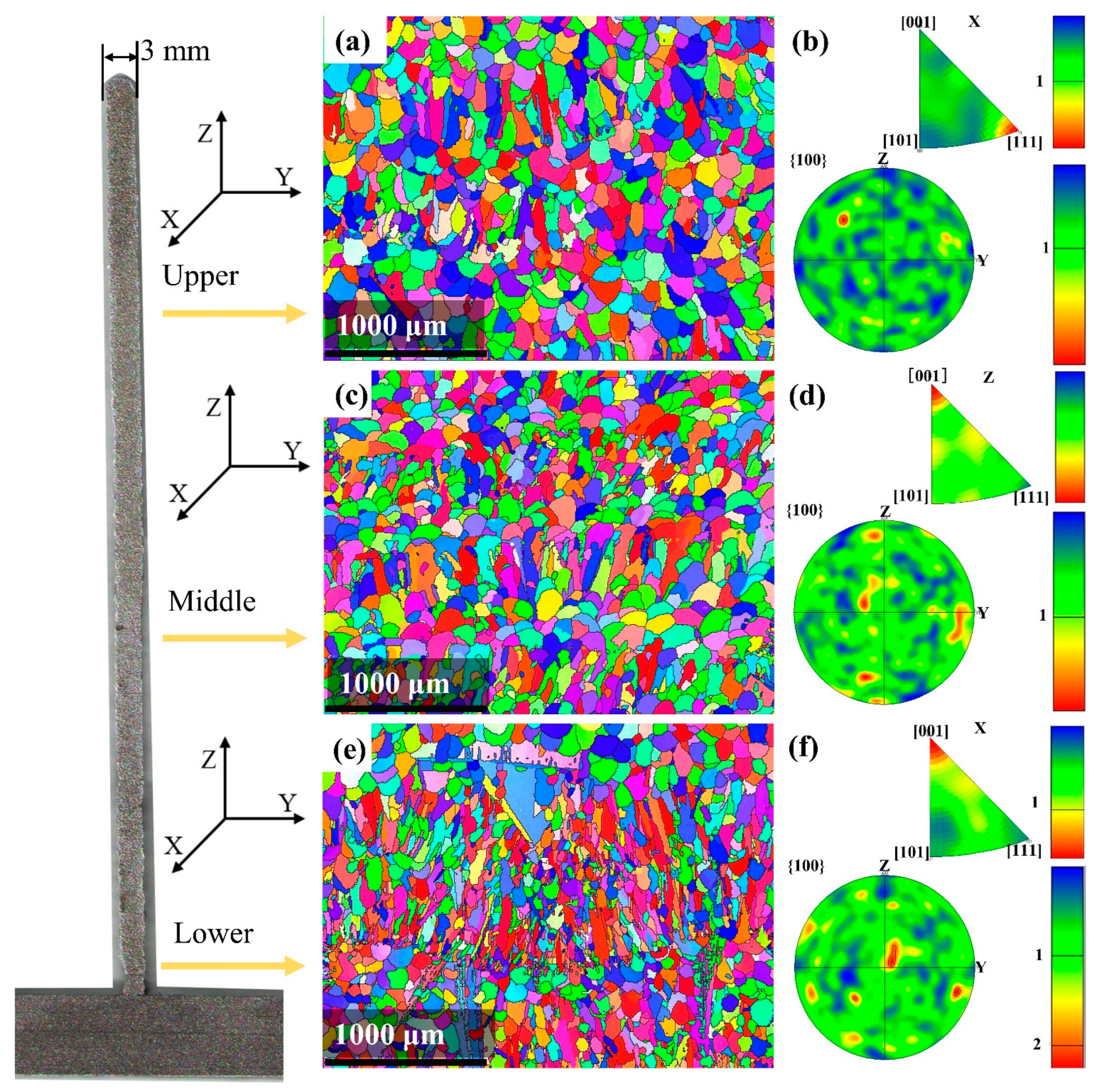


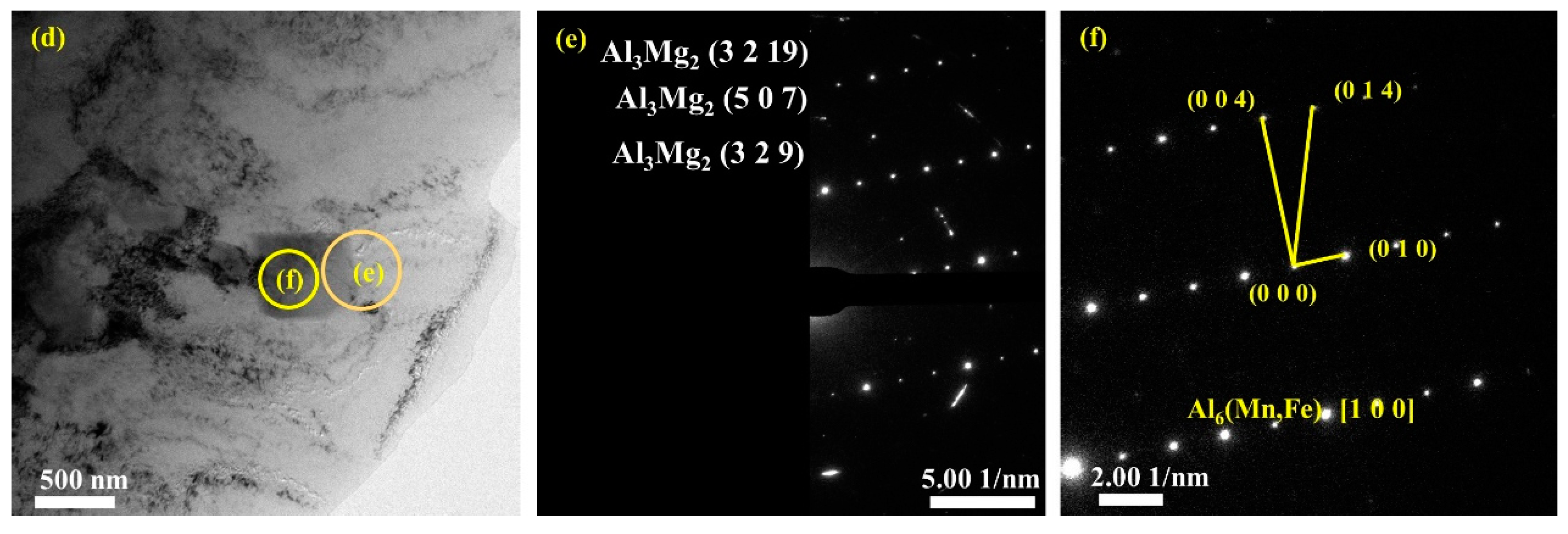
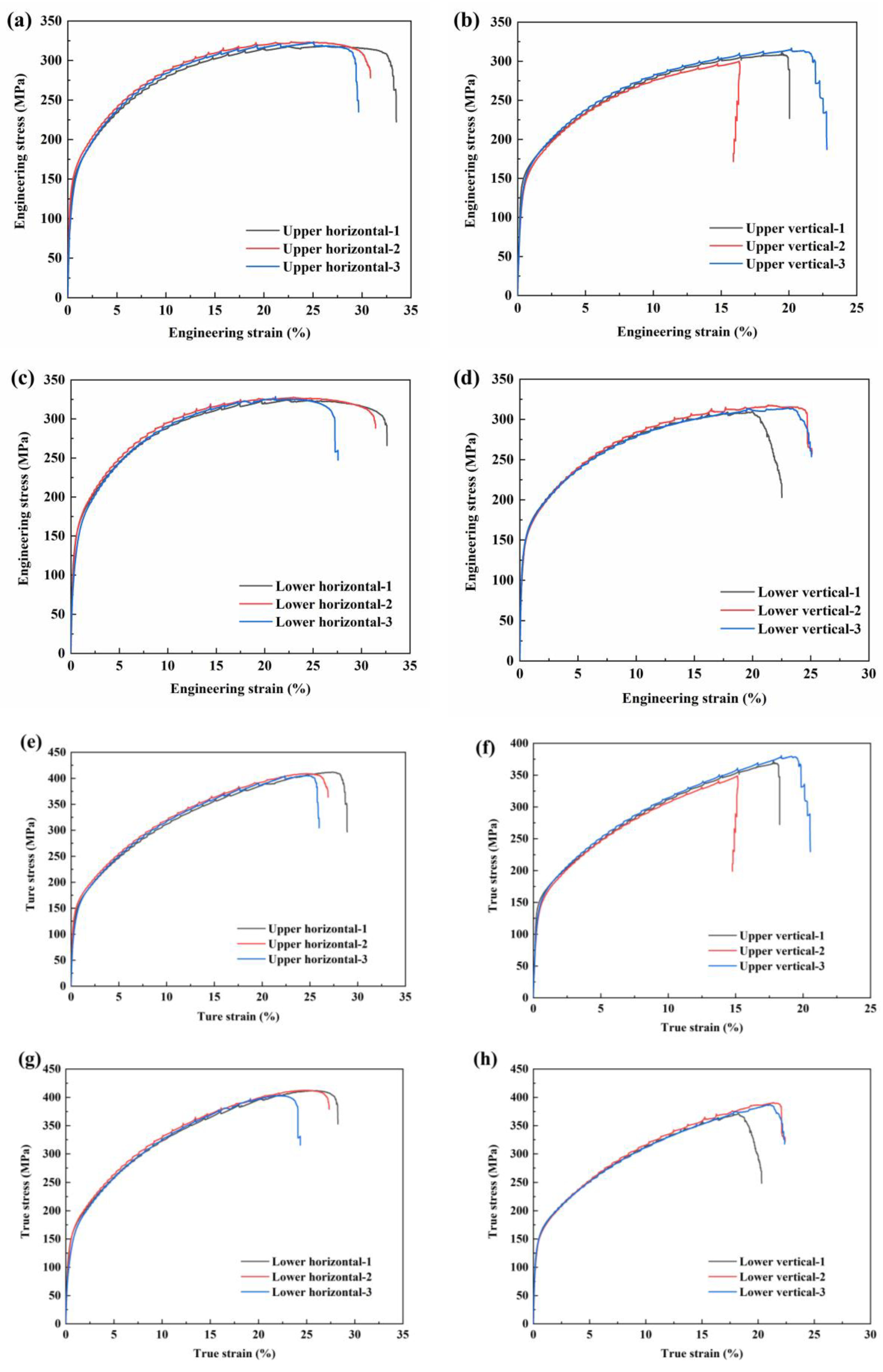
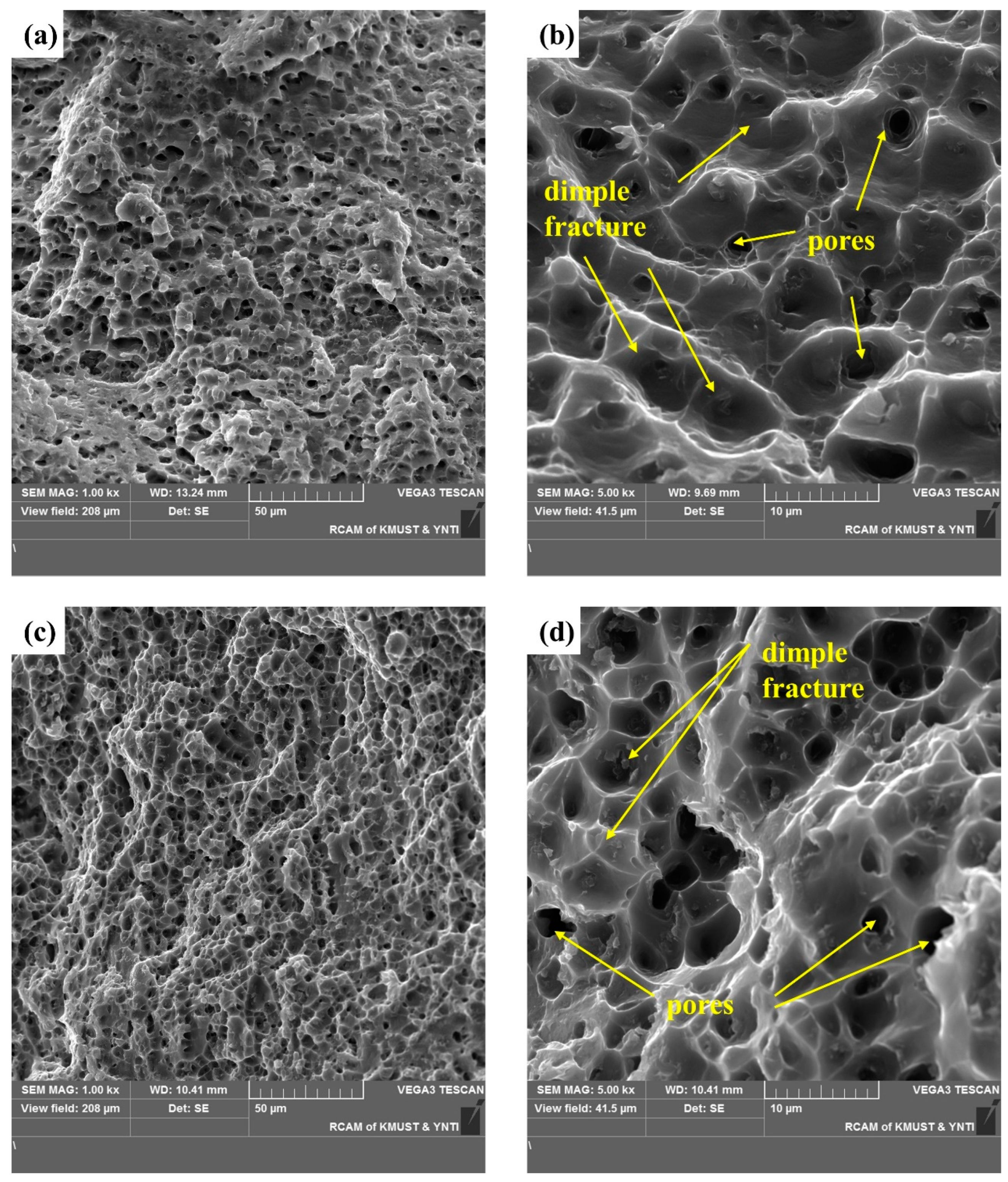


| Element | Si | Fe | Cu | Mn | Mg | Cr | Zn | Ti | Al |
|---|---|---|---|---|---|---|---|---|---|
| As-deposited plate | 0.25 | 0.35 | - | 0.82 | 5.16 | 0.18 | - | - | Bal. |
| Nominal chemical composition | ≤0.4 | ≤0.4 | 0.1 | 0.5–1.0 | 4.3–5.2 | 0.05–0.25 | ≤0.25 | ≤0.15 | Bal. |
| Voltage (V) | Electric Current (A) | Welding Rate (cm/min) | Wire Feeding Speed (m/min) | Residence Time of Each Layer (s) | Single Layer Increment (mm) | Layer (s) |
|---|---|---|---|---|---|---|
| 10.5 | 55 | 110 | 3.5 | 15 | 1.75 | 120 |
| Zone Axis | Lattice Constant (Å) | Corresponding Planes | Lattice Constant (Å) | Corresponding Planes | Lattice Constant (Å) | Corresponding Planes |
|---|---|---|---|---|---|---|
| [4 11 −1] | 2.1645 | (2 −1 −3) | 2.0449 | (3 −1 1) | 2.1598 | (1 0 4) |
| [1 0 0] | 6.4191 | (0 1 0) | 2.1862 | (0 0 4) | 2.0699 | (0 1 4) |
| E (GPa) | YS (MPa) | UTS (MPa) | TUS (MPa) | EL (%) | |
|---|---|---|---|---|---|
| UH-1 | 35.8 | 142.1 | 318.6 | 411.7 | 33.6 |
| UH-2 | 41.6 | 136.5 | 323.7 | 408.9 | 31.1 |
| UH-3 | 31 | 119.9 | 323.7 | 405.1 | 29.9 |
| LH-1 | 36.3 | 141.4 | 326.9 | 411.7 | 32.3 |
| LH-2 | 36.8 | 149.5 | 327.8 | 411.1 | 31.8 |
| LH-3 | 38.7 | 119.2 | 328.5 | 403.2 | 27.7 |
| UV-1 | 50.5 | 152.4 | 312.6 | 368.8 | 20.8 |
| UV-2 | 33.1 | 139.6 | 300.1 | 347.8 | 15.6 |
| UV-3 | 40.7 | 144.4 | 316.8 | 379.4 | 22.9 |
| LV-1 | 46.4 | 139.4 | 309.4 | 370 | 22.3 |
| LV-2 | 58.8 | 138.13 | 317.8 | 390 | 25.3 |
| LV-3 | 58.9 | 144.7 | 314.1 | 386.1 | 26.2 |
| Position | Mg (wt%) | σss (MPa) |
|---|---|---|
| Upper part | 4.5% | 67.2 |
| Middle part | 4.43% | 66.0 |
| Lower part | 2.8% | 39.13 |
| Position | Average Grain Diameter (d/μm) | σGB (MPa) |
|---|---|---|
| Upper part | 97.37 | 24.21 |
| Middle part | 81.4 | 35.52 |
| Lower part | 73.57 | 36.32 |
| Position | f (%) | r (nm) | σ (MPa) |
|---|---|---|---|
| Upper part | 0.5 | 484.72 | 35.2 |
| Middle part | 1.03 | 313.15 | 122.3 |
| Lower part | 1.08 | 348.16 | 125.1 |
Disclaimer/Publisher’s Note: The statements, opinions and data contained in all publications are solely those of the individual author(s) and contributor(s) and not of MDPI and/or the editor(s). MDPI and/or the editor(s) disclaim responsibility for any injury to people or property resulting from any ideas, methods, instructions or products referred to in the content. |
© 2023 by the authors. Licensee MDPI, Basel, Switzerland. This article is an open access article distributed under the terms and conditions of the Creative Commons Attribution (CC BY) license (https://creativecommons.org/licenses/by/4.0/).
Share and Cite
Li, L.; Jia, X.; Hayat, M.D.; Shan, Q.; Li, Z.; Yuan, Z.; Xu, B.; Jiang, Y.; Yang, B. Metallurgical and Mechanical Characteristics of an AA5183 Alloy Plate Performed by a Cold Metal Low-Power Additive Manufacturing Technology. Crystals 2023, 13, 422. https://doi.org/10.3390/cryst13030422
Li L, Jia X, Hayat MD, Shan Q, Li Z, Yuan Z, Xu B, Jiang Y, Yang B. Metallurgical and Mechanical Characteristics of an AA5183 Alloy Plate Performed by a Cold Metal Low-Power Additive Manufacturing Technology. Crystals. 2023; 13(3):422. https://doi.org/10.3390/cryst13030422
Chicago/Turabian StyleLi, Lu, Xianjun Jia, Muhammad Dilawer Hayat, Quan Shan, Zulai Li, Zhentao Yuan, Baoqiang Xu, Yehua Jiang, and Bin Yang. 2023. "Metallurgical and Mechanical Characteristics of an AA5183 Alloy Plate Performed by a Cold Metal Low-Power Additive Manufacturing Technology" Crystals 13, no. 3: 422. https://doi.org/10.3390/cryst13030422




